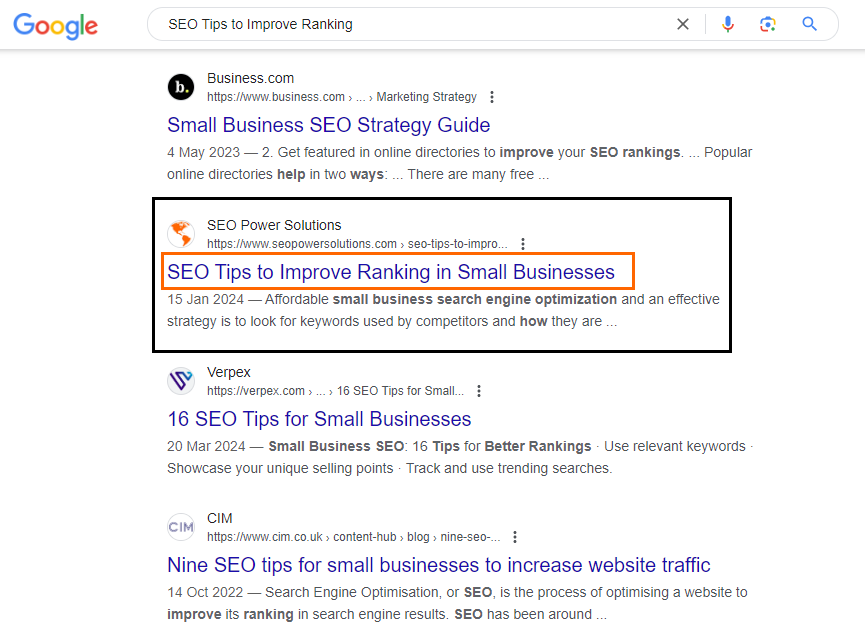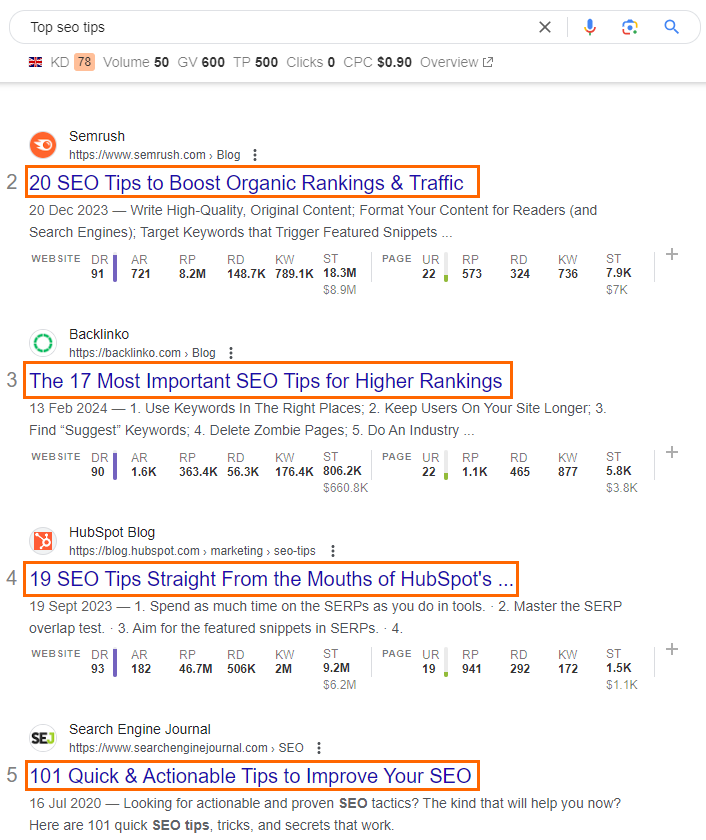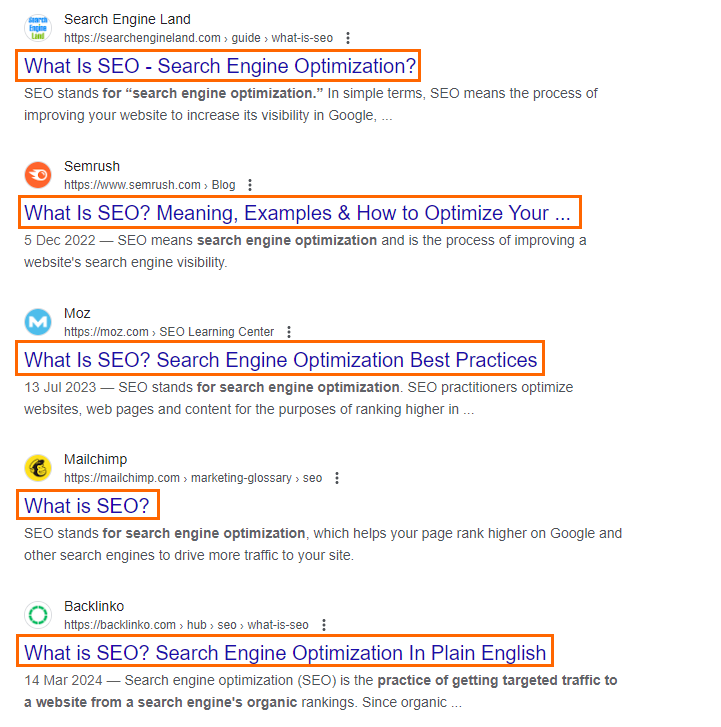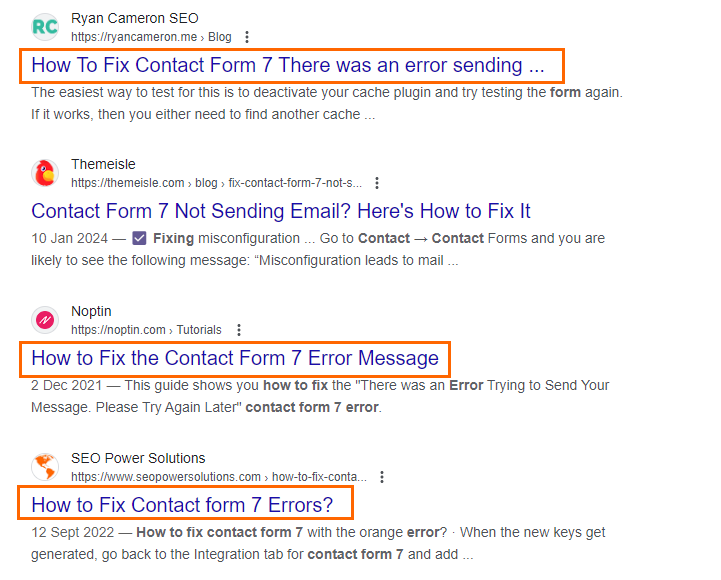Search engines have gained prominence with every passing year. All major institutions (big or small irrespective of its size and nature) now have their official websites listed with the search engines.
With better understanding of SEO rankings, there is an increasing level of competition among businesses to be at the top.
Now, to be at the top means better traffic for your website and your services and offerings get viewed by your prospects.
Companies want to be at the top of search results for their desired keywords. According to First Page statistics, ranking at the top of SERP in your niche delivers 39.8% CTR rates as reported in 2023.
Given that the second and third-ranked results received 18.7% and 10.2%, respectively. Undoubtedly, this is a significant traffic share.
How to Create Captivating Titles?
What entices you to read an article? You have an emotional reaction to a topic or a want to learn more about it. The title of a blog post or article should pique your interest or curiosity. It should also offer the reader a promise.
What Kind of Statement Should The Title Make?
It might inform them that they will gain recommendations and tactics. It should also persuade them that something “they’ll never believe” is true.
A catchy title must also be original. People will scroll by the same-old, same-old. What is the sense of clicking to read more if your titles are the same as every other blog’s?
Best Practices for Catchy Titles
With that in mind, the following recommended effective SEO strategies can assist you in creating attention-grabbing, must-click titles.
-
KISS (Keep it Short and Simple)
Online readers do not have all day. You also do not have much room for a title tag. You want a concise and to-the-point title. The title is crucial so the reader understands what they are receiving straight away. The title, in itself, is not cut off by the search engine.
Consider and incorporate the most information while crafting your title. Make it obvious if you are going to publish a list. If you have produced a lesson or explainer, make sure it is clear from the title alone. Also, limit everything to fewer than 60 characters.
-
Include Keywords in Your Headlines
Creating a title that allows readers to locate and identify your content is a crucial aspect of search engine optimization (SEO). You must make certain that your headlines contain the terms your audience is looking for.

Great clickable headlines must center on the searchable keyword(s), which might be short-tail or long-tail. You may do keyword research using Google Keyword Planner or Ahrefs.
Incorporating keywords effectively into your headlines and content allows your material to appear at the top of the SERP. It makes your headlines more clickable since searchers will see that your headlines represent the information they are looking for.
-
Make use of an H1
Make sure the title of your article is an H1 or the primary heading. Readers may not care if you use an H1 or H2 or just bold the headline, but Google does. When you employ an H1, you are telling Google that the keyword in the title is the most essential one in the content.
Use only one H1 in your article. If you have numerous keywords, Google will become clear and will know the one that is the most significant. Your content will wind up competing against itself, which is undesirable, and will likely rank lower, resulting in fewer hits.
If you have more keywords, utilize them as H2s or H3s throughout the article.
Try Out These Three Headline Formats
Here are three headline formats that have been shown to increase CTRs.
1. List Post Headlines

List-based headlines pique the reader’s interest while providing value to the content. It’s because list headers allow your viewers to swiftly glance through the subheadings to see if there is anything they would like to read more about.
2. Question Headlines

People looking for information frequently ask questions such as, “What is the best way to invest money?” along the lines of “How often should I take a dog to the vet?“ Use the questions they are asking in your titles to show your readers you are on the same page as them and have an answer.
3. How to Headlines

Similarly, when they are deep in a Google search, individuals want to learn something. They could need to learn how to clean their oven, change a tire, or create a best-selling novel. If your material teaches individuals a skill, then include that information in the title.
- How to clean your air conditioning system
- How to Write a Bestseller in 3 Months
- How to make your time more productive
Call to Action
You must sometimes force folks to click on your postings. One method is to include a call to action (CTA) in your title. Make the headline enticing and intriguing so that people are compelled to click.
- See the changes When You Stop Eating Sugar!
- Read this article and Transform Your Life
- Do you need a new phone? Read This First!
Emotional Headlines
Your readers are humans, which means they have feelings. A title that piques their interest will entice them to click and discover more. To increase your CTR, use emotive words, sometimes known as “power” words, in your title. Here are a few suggestions to get you started:
- You will Never Believe What Happens When You Stop Eating Fruit
- See This Actor’s Incredible Transformation
- Overcome Your Fears with Our Course
Numbers in Headlines
If you are constructing a list, use a number in your title. Numbers bring concreteness and help readers connect with your material. They also make a specific guarantee. When the readers click through, they know they will get 5, 7, or 9 suggestions about a topic.
Headline Length Best Practices
According to the Headline Analyzer tool, headlines with 55 characters have the highest click-through rates. However, headlines of no more than 58 characters are permissible.
Although Google formerly limited the width of its title tag to 512 pixels or around 50 to 55 characters, it has lately increased the maximum length of title tags on search engine result pages to 70 characters.
Headlines with 6 to 7 words often garner the most clicks. The maximum number of headline words in a standard best practice should be 10.
Conclusion
SEO Power Solutions will assist you in determining whether your present headlines are better and more clickable, or if they need to be tweaked. Creating the ideal title is both an art and a science, and it is only one component of a bigger content marketing plan. SEO Power Solutions provides full help, including title optimization, to increase your CTR and overall internet visibility. Contact us to explore how we can enhance your online content strategy and drive more traffic to your site.





